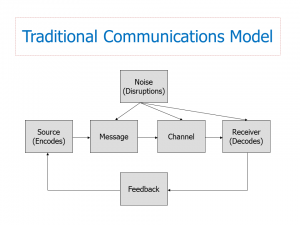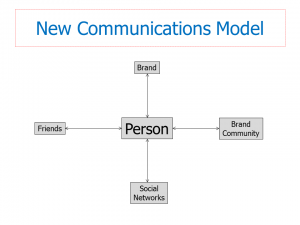I am teaching an undergraduate marketing communications class right now. One of the foundation pieces in the course is study of the traditional communications model and how it works in a marketing context. The model as it has been taught for years mirrors how communication occurs in other contexts- at home, school, work, church, organization meetings- any environment in which you are communicating with other people. But, as I shared the concept with my students I could not help but think the model is outdated for marketing. A different way of looking at communication flow and how marketers should approach the communication process with their audiences is needed.
The Status Quo
In case you are unfamiliar with the traditional communications model to which I am referring, a visual appears below. The most striking characteristic to me (and the one that prompts a call for change) is that the message sender (the marketer) is in command. The model kicks into action when a company or brand wishes to communicate a message to one of its target audiences. The sender controls message encoding (what is said) and channel placement (where it is said). Then, we cross our fingers and hope that the intended recipient is willing to receive it, process it, and give desired feedback (become aware, change beliefs, take action, etc.).
The problem with the status quo is that it is brand centric; more emphasis is put on message sending than being receptive to incoming messages. Case in point, a recent study found that 38 percent of all Facebook posts sent to US brands go unanswered- so much for feedback. In today’s digital world, communication is no longer solely seller driven.
An Alternative Model
Another source of inspiration for questioning the status quo of the traditional communications model came from an article written by Jan Vels Jensen, CMO of Trustpilot, titled “How to Give the Loudest Voice to Your Best Advertisers: Your Customers.” In the article, he advocates that brands seek to replicate old-fashioned conversation by creating digital communities. Stories that customers have about their experiences with your brand, good and bad, should be encouraged rather than something that we get around to if budget and resources allow. The title of the article sums it up- loyal customers can advocate for you, help others by answering questions online, and make you better by giving frank feedback. So, rather than a communications model based on the belief that the marketer is in charge, should we not be approaching interactions in this manner:
It begins by shedding impersonal labels like “receiver,” “consumer,” and “customer.” You want to have conversations with people. Sure, it is great if they do business with us but we want to widen the scope of conversation beyond the typical buyer-seller interaction. The alternative model also proposes that as a business, we are not the only recipient that a person might target. And, the same message might be shared across all channels. For example, have you ever had a bad experience with a business, tweeted or posted to the business’s social media pages, got no response, and proceeded to tell friends, your online social network connections, and even a community of brand users? Thus, the days of ignoring four out of 10 Facebook posts must end. Brands no longer dictate terms of communication. We are a participant and as such should encourage participation through active listening and be ready to communicate when called upon.
Get Over It
The days of brands controlling communication flow are history. Yes, advertising still gives us a channel to use in which we can plan communications (message, timing, and distribution) to a target audience. We can no longer rely on that model alone because customers are talking. Make sure they are heard and give them platforms to not only communicate with you but become your best advertiser.



